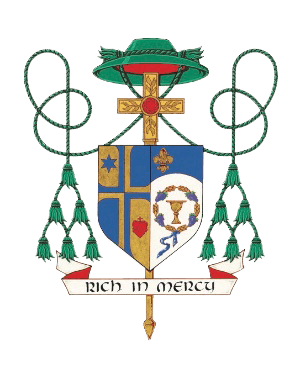Bishop Gerald Vincke

Bishop Jerry Vincke’s coat of arms reflects his motto “Rich in Mercy,” while honoring the history of his new diocese. James-Charles Noonan Jr. of Gwynedd Valley, PA, one of the few Vatican-trained heraldic artists, designed the arms and offered an explanation of its imagery.
Many aspects of the coat of arms point directly to the Eucharist. The left side of the arms represents the diocese, while the right is the new bishop’s design. The six-pointed blue star comes from the original Diocese of Concordia’s shield and symbolizes the Marian title of Our Lady of Perpetual Help, the diocese’s patroness. The heart represents the new diocese, after the see was moved from Concordia to Salina in 1945, and its new cathedral, which was dedicated to the Sacred Heart of Jesus.
The right area of Bishop Vincke’s arms includes a chalice and paten, encircled by a wreath with grapes, grape vines and wheat ears, all representative of the Eucharist. The blue ribbon on the wreath is a nod to the traditional color for Mary, as is the blue area above the wreath. Inside the blue area of the arms is a Fleur de Lys.
The Fleur de Lys is the symbol for Mary as the ‘Immaculate Conception’ which is her title in the United States. In addition to the symbols within the coat of arms, the items surrounding it are also filled with meaning. Atop the coat is a pilgrim’s hat, which is the symbol for all priests and bishops. For the rank of bishop, the pilgrim’s hat is always a deep forest green. The hat is properly known as the galero and the tassels take the name fiocchi. For the coat of arms of a bishop, there are six tassels on each side of the arms. The cords that bind them are known as cordiere. These cords and the tassels are worked in the same hue of green, but the interior of the hat is always rendered in red. This has been so for eleven centuries, red representing the clergy’s possible martyrdom for the vocation that they have adopted in life.
Behind Bishop Vincke’s coat of arms is the episcopal cross, which is rich in symbolism. With the olive leaves on the cross, which reference both St. Francis and St. John Vianney. The red garnet stone is a nod to St. Ignatius of Loyola.
Mercy is the major theme of St. Luke’s Gospel and is mentioned throughout the New Testament, including: Ephesians 2: 4-5 “But because of his great love for us, God, who is rich in mercy, made us alive with Christ even when we were dead in transgressions – it is by grace you have been saved….” ; Hebrews 4:16 16 “Let us then approach God’s throne of grace with confidence, so that we may receive mercy and find grace to help us in our time of need” ; and Titus 3:5 “He saved us, not because of righteous things we had done, but because of his mercy. He saved us through the washing of rebirth and renewal by the Holy Spirit…”
Mercy is also referenced in the Old Testament more than 20 times. It was also a common theme from the visions of Saint Faustina Kowalska (1931), who orchestrated the Image of Divine Mercy.
Noonan’s original design, framed in the Bishop’s office in the Chancery, was hand-painted by Linda Nicholson of Ontario, Canada, a craft painter of the Society of Heraldic Arts in England.
